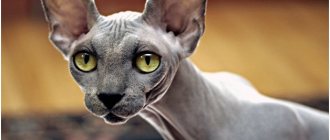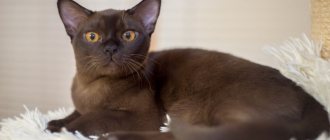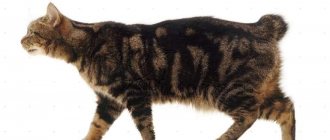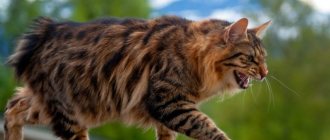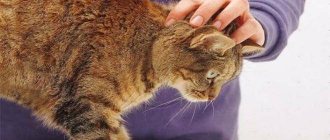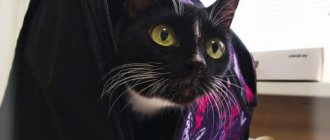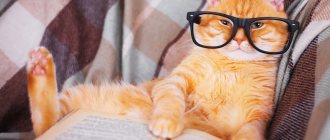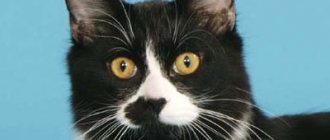For most ordinary people, a cat is a four-legged meowing creature that lives next to a person. Basically, they differ only in appearance: color, type of muzzle or long hair.
The variety of cat breeds is multifaceted, among them there is a breed of cats with short legs, with long or completely lost hair (see what is the name of a cat breed with short legs). But there is a very unique breed with a tail that is in its infancy, or completely missing.
It is not stopped at birth like in dogs, but is a distinctive elite feature. Many clients are willing to pay big money for this originality.
The history of the appearance of tailless cats
All tailless cats, with the exception of hybrids and pixie-bobs, are the result of natural mutation that occurred in limited geographic ranges. Depending on the place of origin, they are divided into 2 groups:
- Manx cats born in the British Isles;
- bobtails that appeared on the territory of Japan, which for a long time led a predominantly closed lifestyle.
The relationship of these animals has not been proven, but it has not been disproved either. One part of felinologists is inclined to the theory of parallel and separate development of each of the groups, and the second - to the theory of the movement of “mustaches” from one area to another along with people.
INTERESTING!
According to one legend, the bobtailedness of cats is due to the slowness of their distant ancestor, who jumped into Noah’s Ark at the very last moment. Because of this, the closing door pinched his tail.
British breeds
The first mention of cats without a tail dates back to the mid-18th century. Representatives of this group appeared on the Isle of Man, located between Great Britain and Ireland. Local breeders quickly fixed the mutation in new generations, arousing great interest among breeders from Europe and America.
In appearance, Manx cats resemble the classic chubby-cheeked “British”. Most of them have short hair, but in Canada there is also a separate long-haired variety.
Japanese breeds
In Japan, bobtails are called maneki-neko, or “alluring cat.” Ceramic and porcelain figurines with their image are often displayed in shop windows, restaurants and other establishments in order to attract good luck. Despite the modern reverence for cats without a tail, the alleged history of their appearance is rather dark and sad.
The Japanese believed that in old age, domestic cats turned into nekomata - dangerous demons (youkai) that kidnapped and ate people. A distinctive feature of these creatures was their forked tail, so enterprising owners began to cut it off for their pets in childhood.
The systematic destruction of the long tail led to a genetic mutation. Kittens with a fluffy pompom began to appear, so the breeders just had to secure its inheritance.
Castration and sterilization
Animals that do not meet standard breed characteristics and are unsuitable for breeding must be spayed or neutered to avoid unwanted matings.
At what age is it recommended to have surgery?
Castration or sterilization surgery is performed:
- for females - at 8–12 months (preferably before two years);
- for males - after 10 months.
Caring for your pet after surgery
Proper care of your pet after sterilization or castration surgery involves the following measures:
- immediately after the completion of surgical procedures, a special postoperative blanket and an “Elizabethan” collar are put on the animal to prevent sutures from licking;
- providing the pet with peace and quiet;
- daily treatment of postoperative sutures with disinfectant solutions (hydrogen peroxide, chlorhexidine, etc.);
- After the operation, the animal cannot be fed for 10–12 hours;
- limiting the pet's activity to avoid damage to the sutures.
After spaying or neutering surgery, it is necessary to put a post-operative blanket and collar on your pet.
All cats react differently to anesthesia. Some come to their senses almost immediately, while others sleep for a very long time. Our cat moved only along the wall for more than a day; she swayed in all directions. She started eating on the third day, but she returned to normal only a week later, when the blanket was removed.
Varieties by tail length
The tail of the most common “moustache” consists of 20-26 caudal vertebrae. With mutation, this amount decreases sharply. Depending on the final length, the following varieties are distinguished:
- rampi – 0 vertebrae;
- riser – 1-3 vertebrae, noticeable only with short hair;
- Stumpy – 4-8 vertebrae;
- longs, or tails, are close to the usual ones.
In cats without tails, the last 2 options are considered disadvantages. For show breeds, the preferred length is within 4 cm. Longer varieties are accompanied by tuberosity and knobbiness.
All varieties of tailless bobtail cats
Among the officially recognized varieties of cats without tails, the Bobtail breed has 6 representatives. All others are classified as hybrids.
Japanese
Thanks to their congenital bobtail, bobtails simply could not turn into nekomata, which aroused great interest among the inhabitants of the land of the rising sun. Unusual animals quickly received a privileged status and found their way into the palaces of Japanese rulers.
IMPORTANT!
Despite the lack of a standard number of vertebrae, the tail of the “Japanese” is very sensitive. Sharp touches in this area can lead to severe pain.
The “Japanese” came to America only in 1967, but a year later they received a standard and official recognition from the CFA. Long-haired representatives had to wait much longer. Until 1991, they were persistently rejected from breeding.
Despite their Asian roots, Japanese cats are very different from the classic “Orientals”. They are famous for their hot temperament and passion for adventure. The peak of their activity occurs in the first year of life, but the playfulness itself remains until old age.
Kuril
According to felinologists, these fluffy “mustaches”, reminiscent of a miniature lynx, appeared as a result of natural crossing of Japanese bobtails and “Siberians”. They are distinguished from the “Japanese” by their larger size and non-retractable claws.
The tail of the “Kurilian” is unique. The standard allows for as many as 4 variations:
- “stump” – motionless and very closely spaced vertebrae with knobby thickenings;
- “broom” is a relatively mobile variety, characterized by a zigzag arrangement of vertebrae;
- “spiral” – severe deformation of the vertebrae, bending them towards the back (differs from the “broom” by greater mobility and sharper angles);
- “retracted bobtail” is a subtype of “spiral” with a bend at the very tip (refers to defects).
The shape of the fluffy pompom is not regulated. It can be changed at will, even in show animals.
“ More about the Kurilian Bobtail breed
Karelian
The “Karelians” were considered for a long time to be close relatives of the “Kurilians,” but genetic tests refuted this theory. The ancestors of these animals turned out to be wild and Norwegian forest cats. The Karelian Bobtail standard was recognized internationally in 1994, but due to the difficulty of breeding, until 2012 only a small number of enthusiasts were involved in breeding.
In the wild, “Karelians”, like lions, live in prides. For this reason, they easily find a common language with other animals and do not experience jealousy towards them.
In addition to their origin, “Karelians” differ from “Kurilians” in their smaller dimensions. They practically do not meow and prefer to communicate using uterine sounds reminiscent of rumbling.
American
The fluffy “American” originates in Southern Arizona. His ancestor is a mongrel short-tailed kitten, picked up by a young couple near an Indian reservation. Despite this confirmed fact, some felinologists associate the appearance of the breed with a random mutation of ragdolls.
The American received official recognition in 1989, but is still only bred in North America. In the USA, the “mustache” is often involved in canistherapy, as he is good at detecting changes in people’s moods and loves to keep them company.
Mekong
This cat got its name in honor of the Mekong River, which flows along Southeast Asia. Until 2003, it was called either the Siamese or the Thai, which caused much confusion with existing breeds.
INTERESTING!
The first Mekong Bobtails lived in the grounds of palaces and temples. According to legends, princesses wore rings and bracelets on their curled ponytails so as not to lose their jewelry while swimming.
Representatives of this breed are notable for their characteristic Siamese coloring and blue eyes. The brighter the color of the iris, the more expensive the kitten is. In addition to seal point, the standard also allows red, tabby, blue, chocolate and cake points. The exact type of coat is determined only when they grow up, since kittens with a temperature-dependent color are always born snow-white.
Pixiebob, or short-tailed elf
Pixiebobs are a unique case. They did not appear by chance, but thanks to the targeted selection of ordinary furry “nobles” and wild short-tailed cats found in the forests of the USA and Canada. The purpose of these breedings was to create a miniature version of the lynx.
Despite the efforts of breeders, most kittens were born sterile for a long time. The problem was solved only in 1985, and 4 years later the new breed received an official standard.
INTERESTING!
The pixie bob standard allows for polydactyly, or multiple toes. The number of toes on one paw can reach seven.
Pixie bobs are not common in Russia and are very rare in Europe. This is due to a strict ban on export outside America.
The main feature of the representatives of short-tailed elves is their spotted color. The size of the spots varies from small to medium. The presence of residual tiger stripes, as well as white “medallions” on the chest, is considered acceptable.
Hybrids
These animals were obtained by crossing the above breeds. These include:
- Scythian Bobtail is a dwarf variety of the Mekong Bobtail;
- snow bob – white American bobtail;
- Highlander – American Curl + American Bobtail.
The Skif Toy Bob is the only hybrid from Russia recognized by the MFA as an experimental breed in 2021. Its weight is only 1.5-2 kg.
Health
This breed boasts strong and good health. They have virtually no predisposition to genetic diseases. The occurrence of such diseases is possible only if the crossing of parents was carried out incorrectly. For example, one of them is a representative of a hybrid breed.
In other cases, health problems may arise due to improper care and feeding of the animal. If the amount of carbohydrate food in the diet exceeds the norm, there is a risk that the cat will suffer from obesity and diabetes. Neglecting to brush your teeth can lead to periodontitis.
Tailless cats are not bobtails
Tailless cats also include Manx cats and their close relatives: Cymrics with long hair and Ouhi-bobs, obtained through crossing with Siamese. The latter breed is experimental and has no official recognition.
Manx
The Manx is the main asset of the Isle of Man. They are common in their homeland and in North America. In the former socialist countries and Europe they are practically impossible to find, which explains the high cost of kittens.
The Manx standard allows for any variety of colors except lilac and chocolate, including their combinations with white spots. The most preferred type of ponytail is the rampie. In the absence of vertebrae, a characteristic fossa is felt at their base.
Cymric
Cymrica is recognized by most felinological organizations, but in fact it is a long-haired variety of Manx. Due to its compact size, pom-pom tail and intense fluffiness, this cat is often called the “little bear.”
INTERESTING!
When breeding Cymrics, Manx are used.
Kymrik is not afraid of water and moves with the jumps characteristic of a hare. The fur on its paws forms luxurious “pants.”
Oooh-bob
Despite its name, the oohee bob is not a bobtail at all. This experimental breed was created by crossing a Manx cat and a Siamese cat. From the first parent, the “mustache” inherited the bob tail, and from the second, the temperature-dependent color.
How to care for Manx
It is very important whether your representative is short-haired or long-haired. If your pet has short hair, it is enough to brush it once a week and wipe it with a damp towel. A long-haired cat is brushed two to three times a week, and every other day during shedding.
It is recommended for a cat to brush its teeth once or twice a week, and to care for its ears and eyes at the same frequency. Dirty ears are cleaned with a cotton ball dipped in a vinegar solution. Cotton wool or soft cloth is also used for the eyes. In this case, each eye is wiped separately.
It is very important to keep the litter box clean. Then the cat will be quite happy.
Manx cats are not demanding when it comes to food. Include wet and dry food with turkey, rabbit, chicken, as well as natural food in their diet. The cat is given fresh fish.
It is advisable to feed pets 3-4 times a day. But if this is not possible, give food at least twice a day and make sure that the cats always have clean water. It is also important to properly divide food into portions, as animals are prone to overeating.
To determine the required amount of food, carefully monitor the size of your pet. Typically Manx eat standard portion sizes. It is quite enough for cats to eat properly and develop.
Features of cat breeds without a tail
Despite some external differences, all tailless cats have a similar “dog-like” character, strong immunity and unpretentiousness. The only disadvantage of these animals is their tendency to a number of diseases.
Character
Cats without tails are very smart pets, endlessly loyal to their owners. They easily tolerate moving and love traveling together. When they find themselves in a new family, the “mustaches” become attached not to the place, but to the people living there.
Bobtails and Manx cats quickly become accustomed to the toilet and scratching post. With regular training, they can also be taught simple tricks and the “Fetch” command.
Animals get along well with children and take part in joint games with pleasure. Relationships with other pets depend on their size. Due to their innate friendliness, problems usually do not arise with dogs and other cats, but it is better not to keep “mustache” animals with rodents and birds due to their developed hunting instinct.
